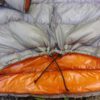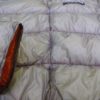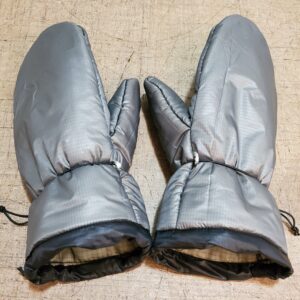The SUL (super ultralight) series garments are aimed at pushing weight as low as possible for a given fill amount, without compromising function. These are down sweaters in the strictest sense. No zippers, no pockets, no linings, no webbing, just insulation in the form of down in a nylon shell. Now available with zippers and pockets.
Fill type – 900fp goose down
Fill weight – 1.7oz (small), 1.8oz (medium), 2oz (large)
Total weight – 4.5oz (small), 5.5oz (medium), 6.2oz (large)
The goal with the SUL .75 down sweater was to make the lightest jacket possible while achieving functional warmth. Calculated loft is .75″. It is surprisingly warm for such a light garment. Alone, I estimate this to go down to freezing while inactive, but it’s probably getting uncomfortable for most people in the 30s (Fahrenheit). It has a cinch at the neck and a cinch at the bottom hem to keep out drafts. Both cinches are removable. One should plan on adding room for loft in the fit. When in doubt, oversize. A snug and fitted puffy is cold. A loose fitting puffy is warmer and usually ends up covering more of your body.
It’s a great garment to pair with the Alpha Direct Hoodie and Wind shell. Those two cover a huge range of active scenarios. Add the SUL .75 to the mix and you extend the static insulation capabilities quite low. The Alpha inner layer, SUL .75 mid layer, wind shell outer layer combo can provide solid 4 season warmth. Keep in mind that a wind shell may need to be upsized to prevent compression when layering over a puffy.
A puffy is most often used as an inactive layer for stops, at camp, or to help boost a sleep system. They don’t make for very good active layers since your sweat can easily compromise the down fill. This makes a zipper for ventilation a somewhat frivolous feature that can add a significant amount of weight and bulk. Pockets can be nice to have, but they often add a big chunk of weight and bulk and compromise the performance of a jacket by creating cold spots and by pulling insulation flat when there is weight in them. For those wanting pockets to warm hands I recommend adding a few inches to the sleeve to cover your hands. This is lighter than pockets and doesn’t compromise the overall warmth. All non-essential sewn through lines have been eliminated so the down can loft and cold spots are reduced. Simplicity and reduced weight and bulk are not the only benefits of all this. Leaving off many tedious features also reduces my labor and allows me to offer a very affordable jacket at an extremely low weight.
It’s meant to be used with a modular hood or head insulation, but can be built with an integrated hood.
More warmth out of less fill Sewn Through Baffle Construction and Its Effect on Warmth – Timmermade
These are now available with zippers and pockets, but one should expect each of these to reduce the effectiveness of these garments. The zipper isn’t too bad, but it’ll increase the cold spot in front, and add a chunk of weight. The pockets will add two big cold spots on the sides and placing weight in them can cause shell tension and loft loss. The design of them is intended to limit this effect, by attaching the pocket to points that transfer load up to places that already have sewn through spots. However, it is inevitable that weight will still pull some loft flat. The wearer should be aware of this tendency to try to limit the weight placed on the shells. Storing light things and warming your hands with them supported by something other then the pocket will be less detrimental.




























Steve Bateman (verified owner) –
Not fashionable, but does what it is intended for. Great quality, but that’s what you are paying and waiting for, right? Medium with 26″ neck came to 5.29oz. I have a big head, and my TM 1.5 Down Sweater has a 25″ neck. I thought that was a bit tight and claustrophobic getting off, so I ordered this in a 26″. At the time the standard neck size was 25″, but right after I ordered this at 26″ the standard size was changed to 26″. Upon wearing, and more experience with this type of layer, I’m not sure I would go with 26″ again. If you have a small head I would definitely order this with a 25″ for heat retention.